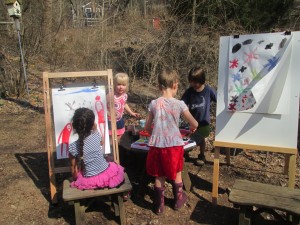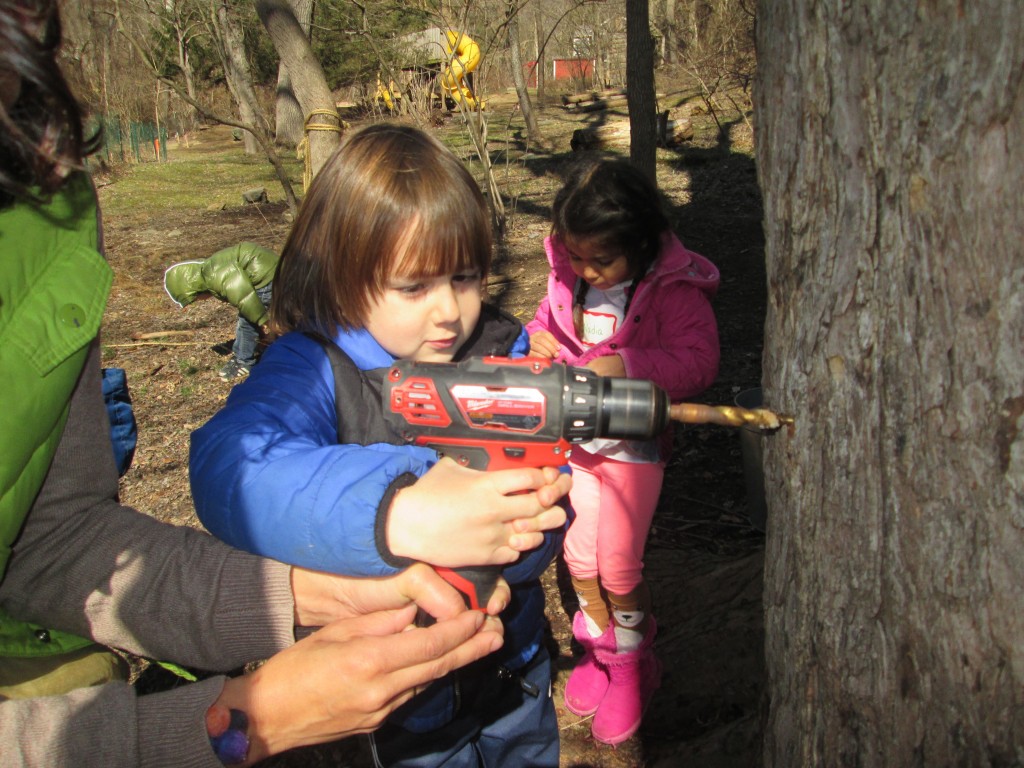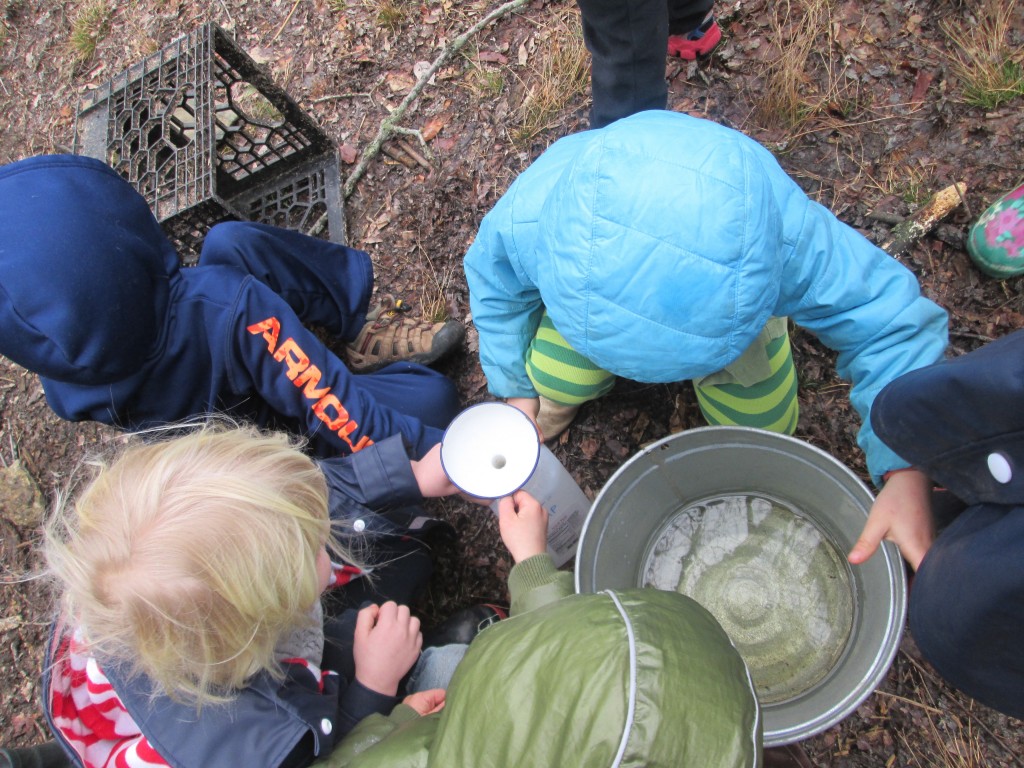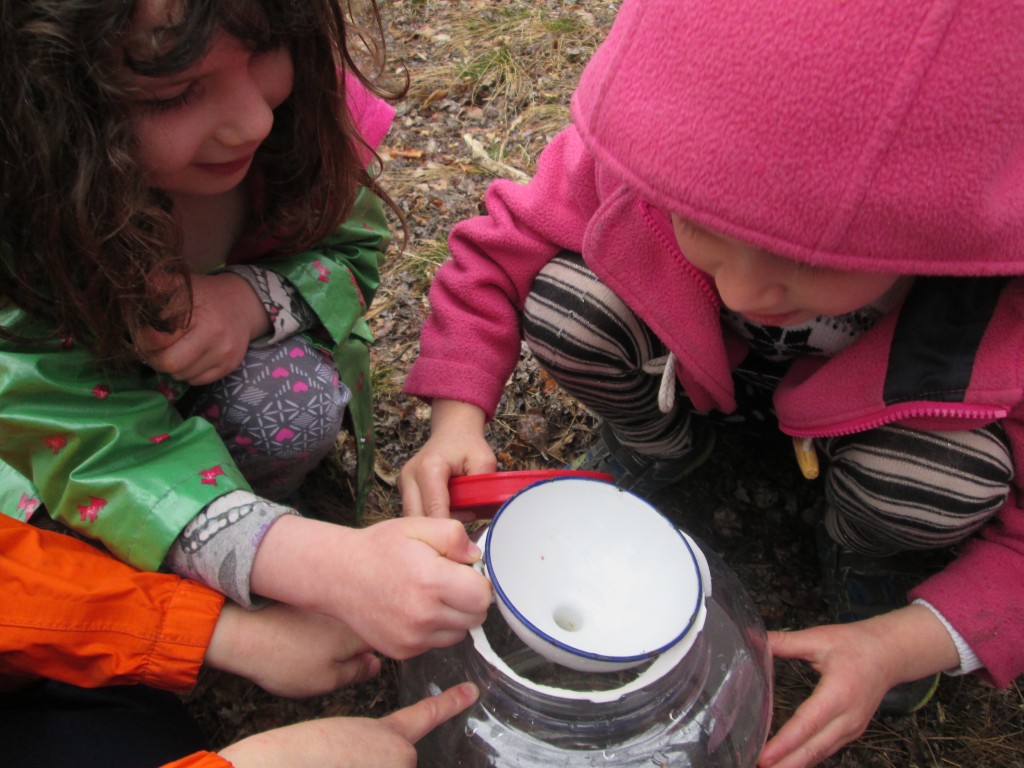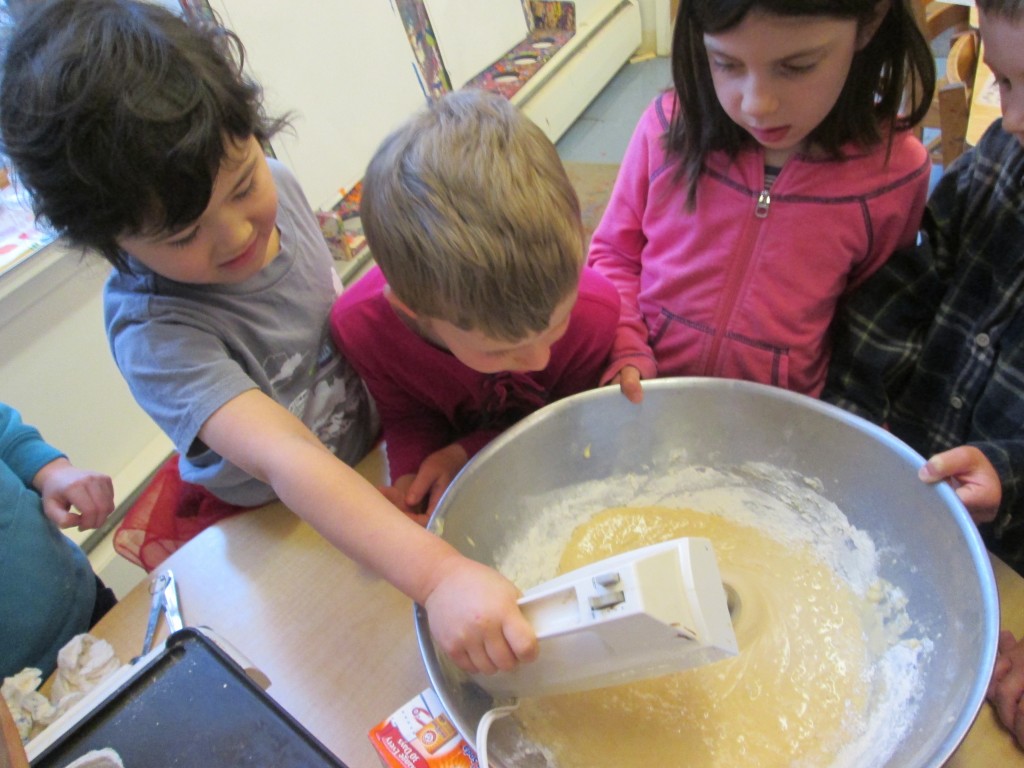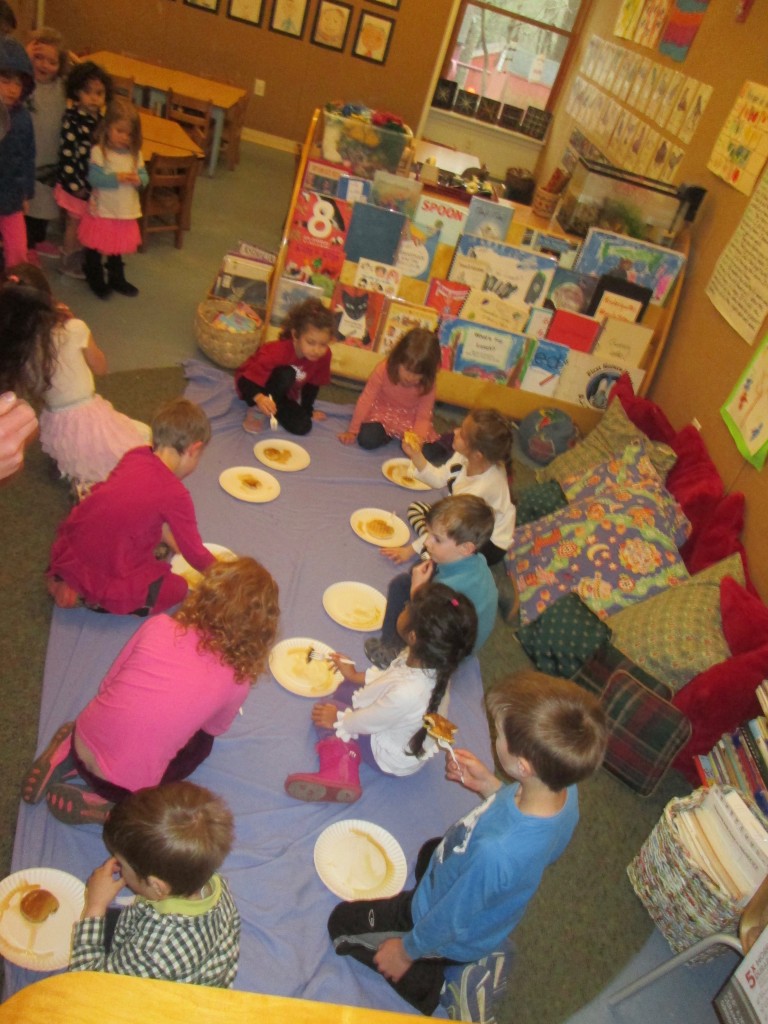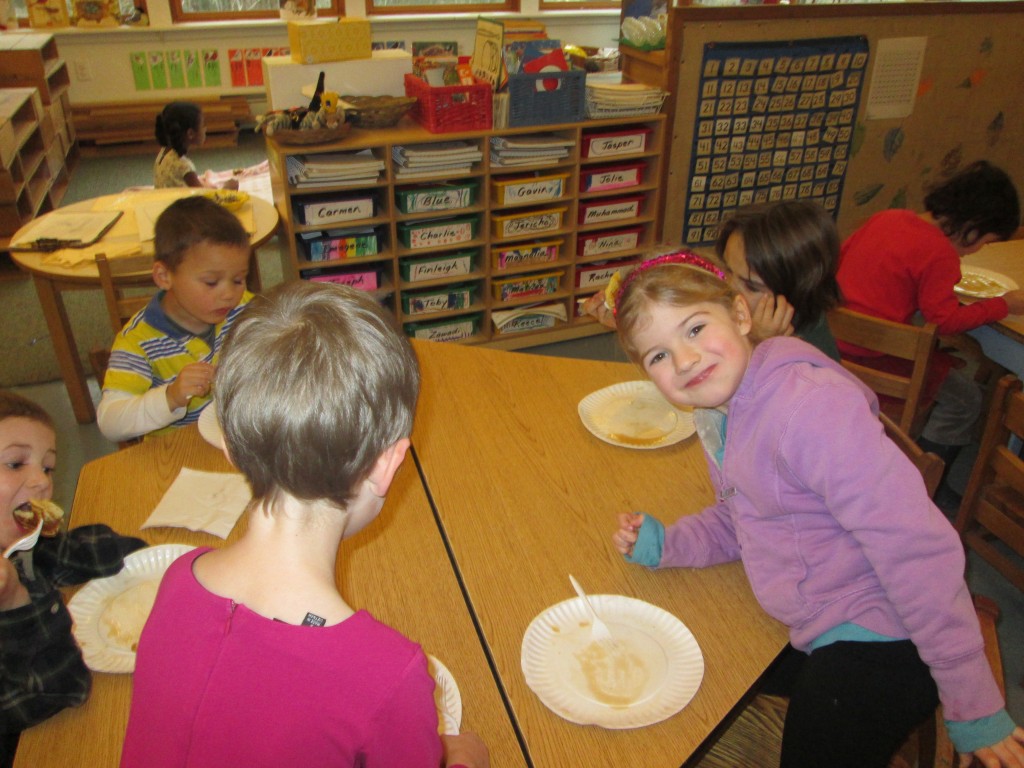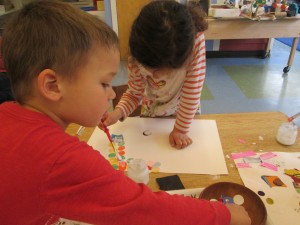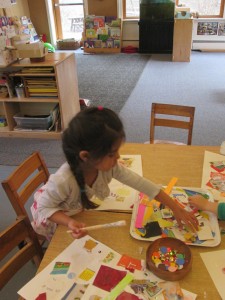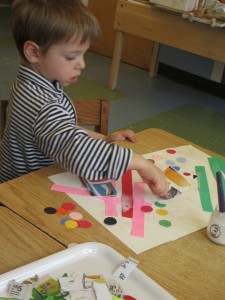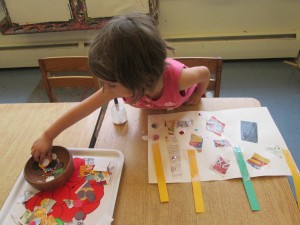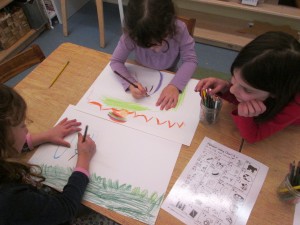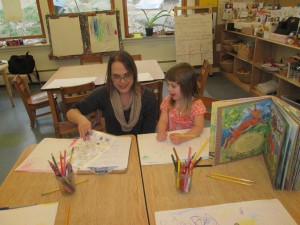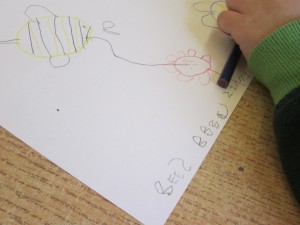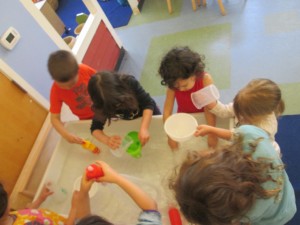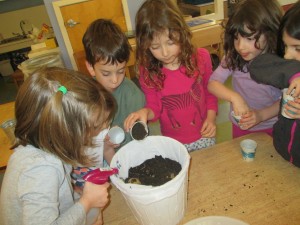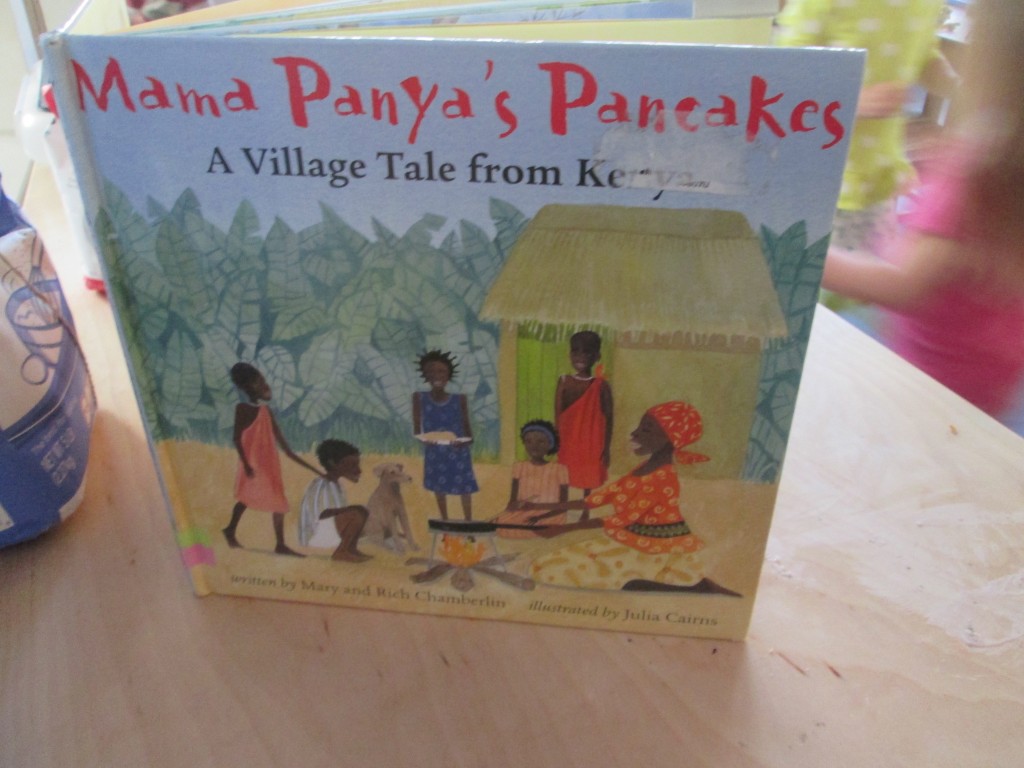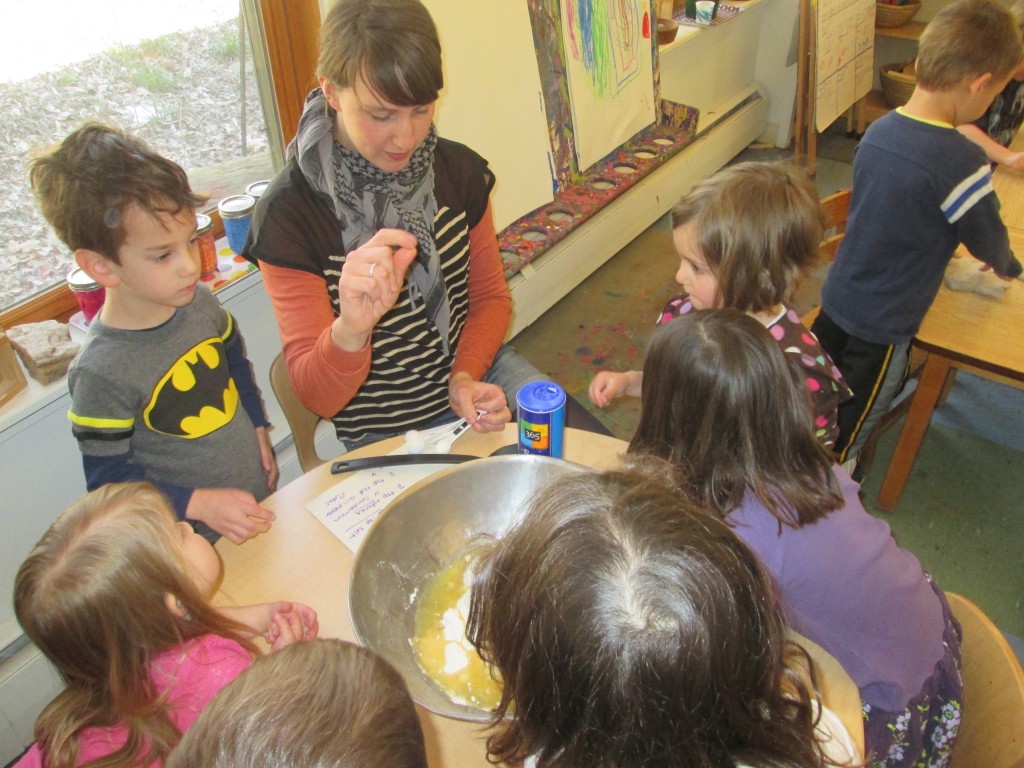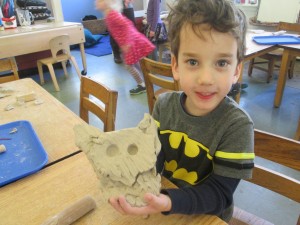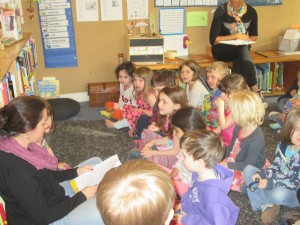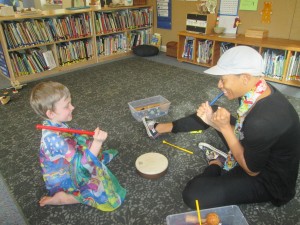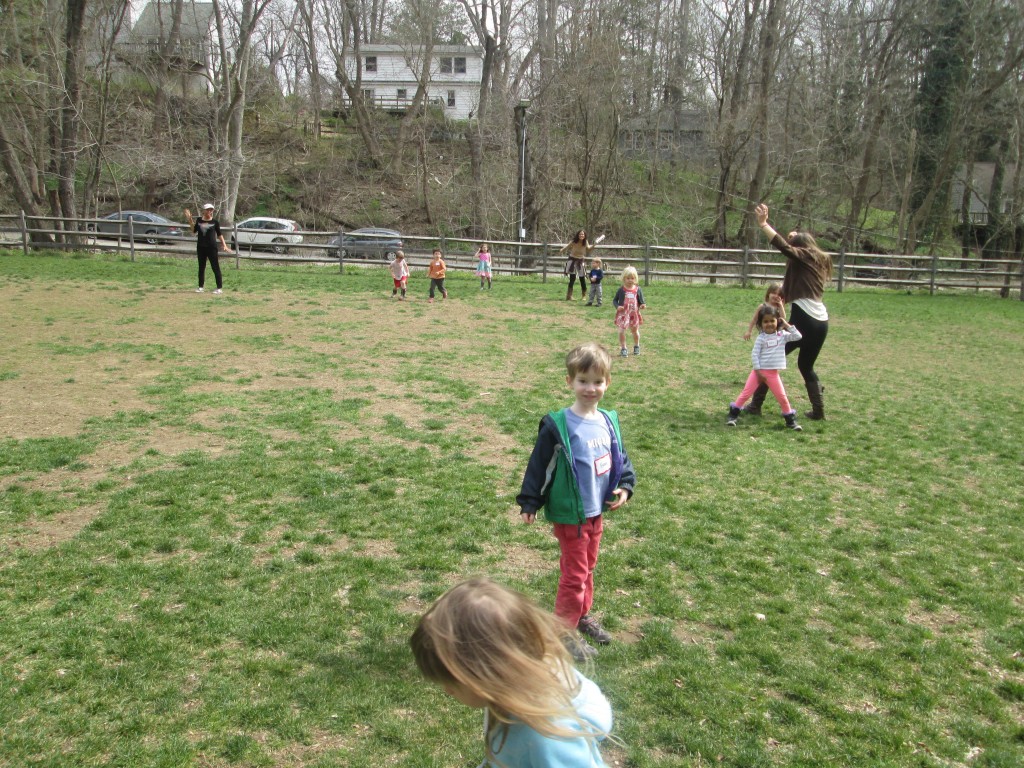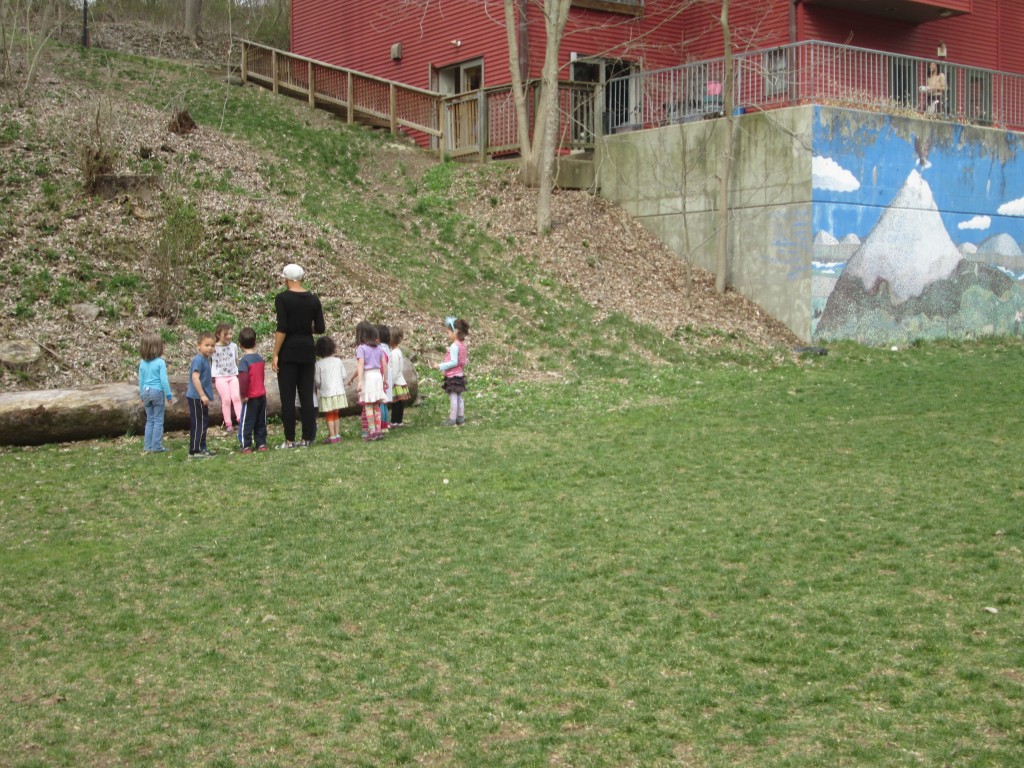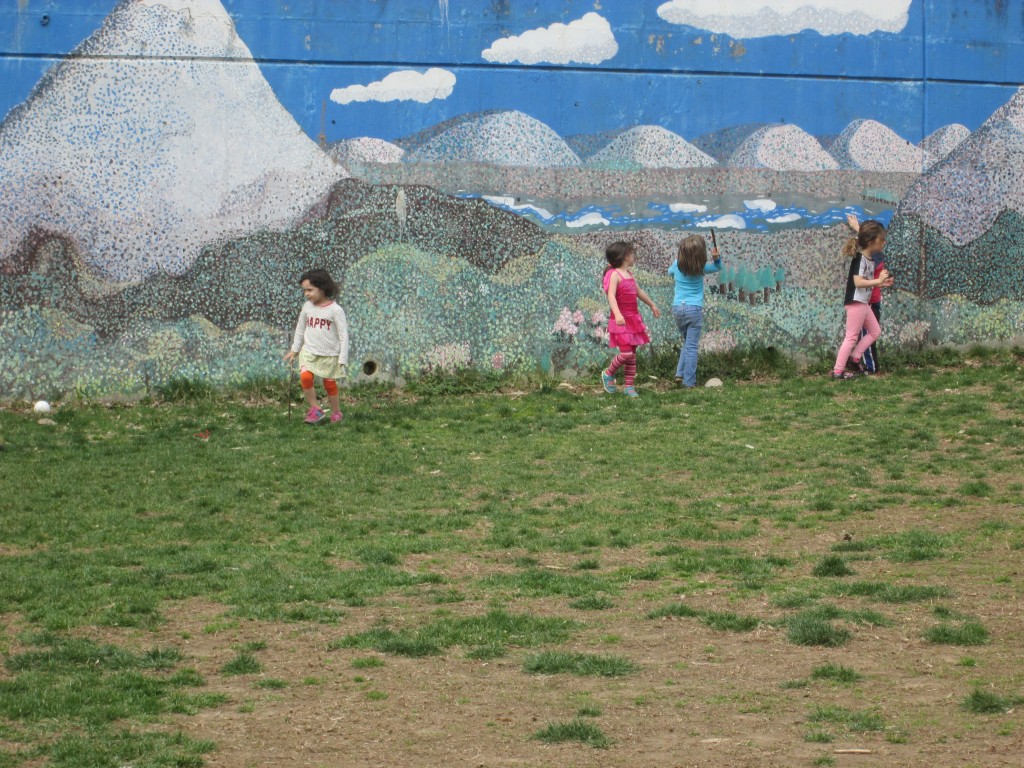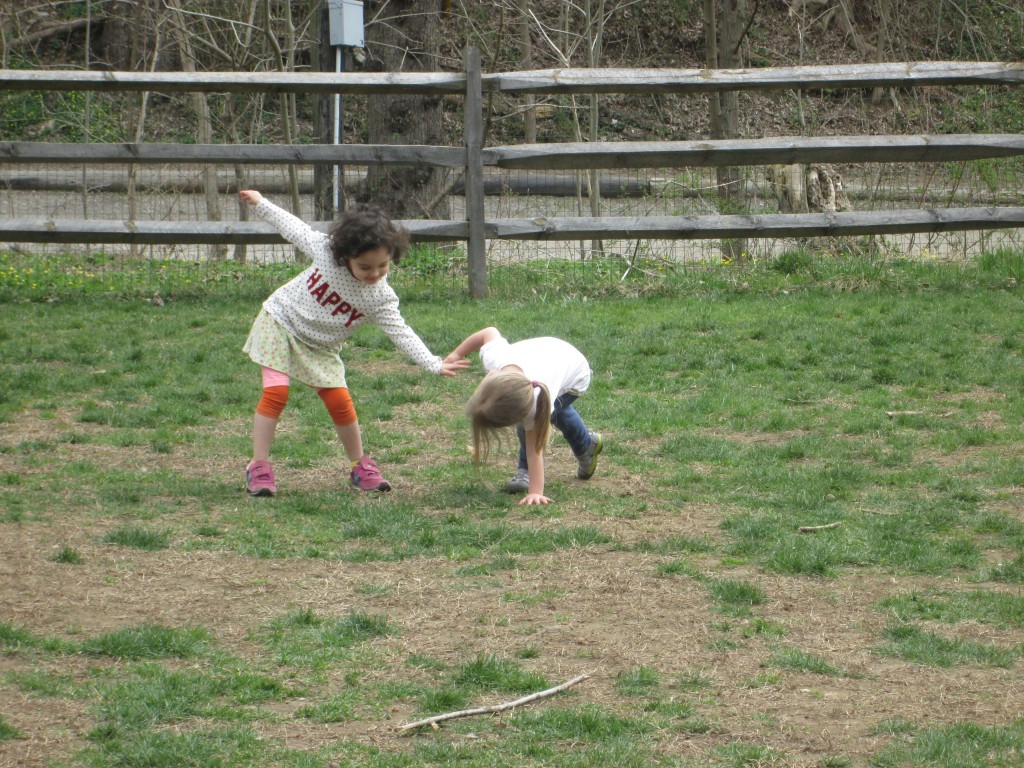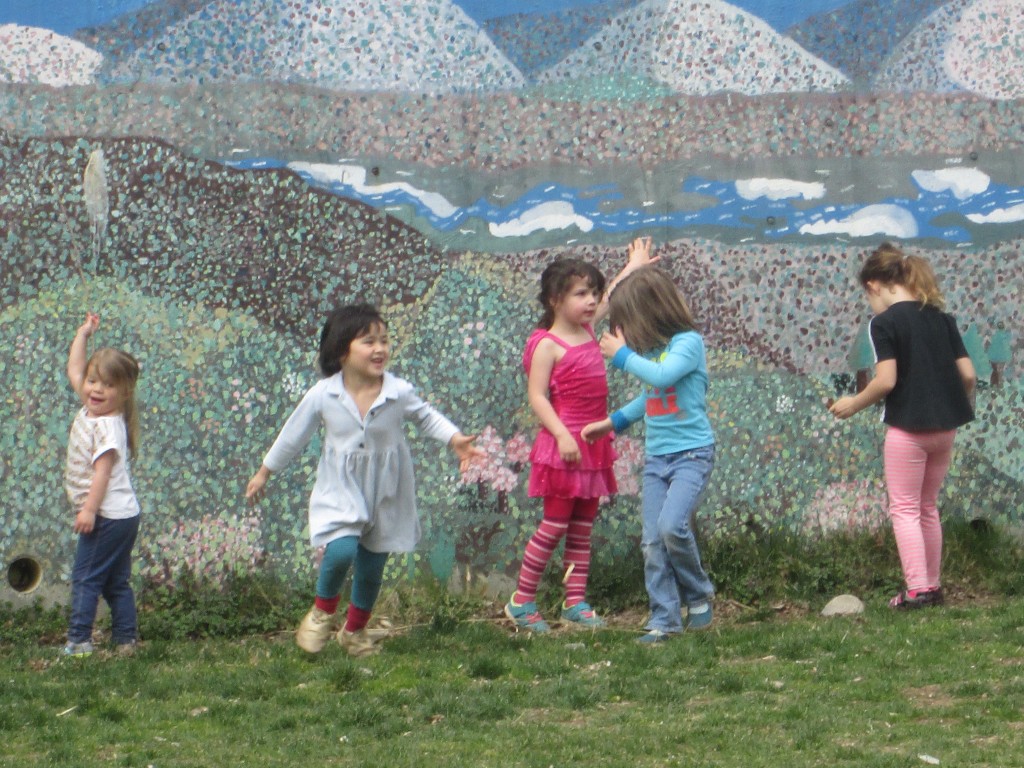“You know why I like science? Science is discovery.”
February and March brought us chilly nights and mild–even balmy–days. The winter thaw drew the nursery learners outdoors for some scientific inquiry as they investigated maple sugaring, explored further parts of the creek, took lunch out on the playground, and dug into the sand to construct a new stream. Felix exclaimed a few days ago, while working on the stream site, “You know why I like science? Science is discovery.” Here is a sampling of some of that discovery.
Maple Sugaring
Knowing where our food comes from helps us understand the interdependence between humans and the natural world. Additionally, collecting the sap generates children’s ideas about numeracy and measurement, and boiling down the sap demonstrates the evaporation process. Every other year we tap our Silver Maple in Monkeyland to begin our sugaring study. Mike helped us drill the spiles into the tree, and the sap was running! But even more exciting was the discovery that sap comes from trees and that sap transforms into syrup!
Quinn: We drilled it in the tree.
Miles: And sap came out.
Ariella: It can be made into syrup.
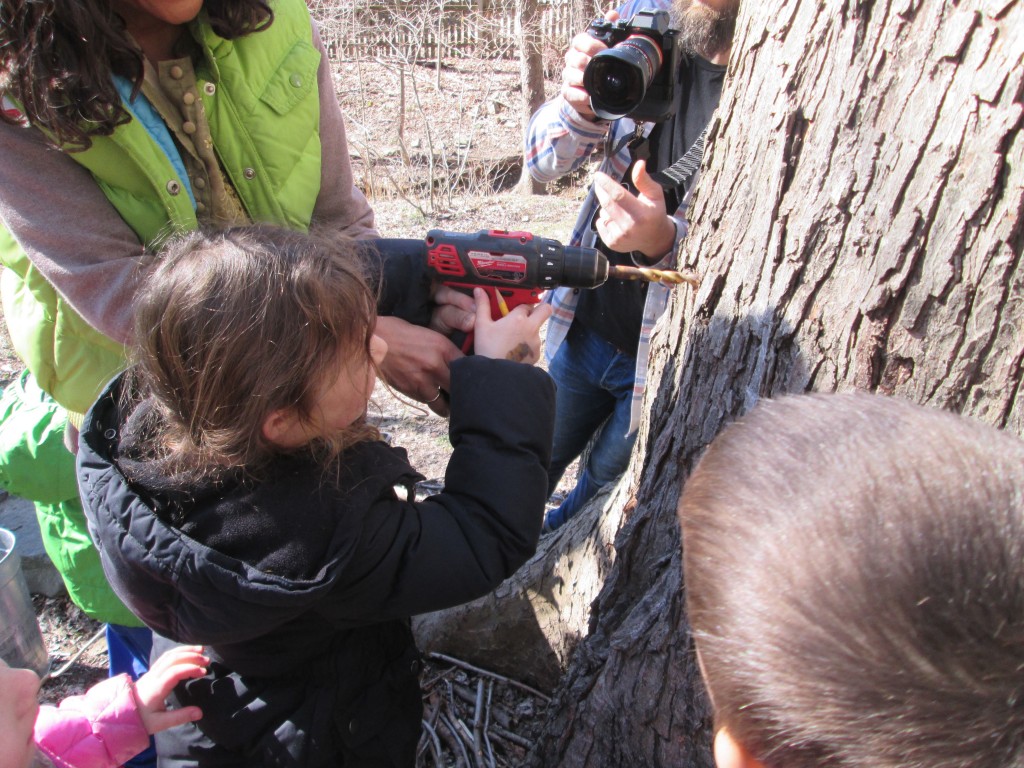 “We drilled it in the tree.” “It’s dripping!”
“We drilled it in the tree.” “It’s dripping!”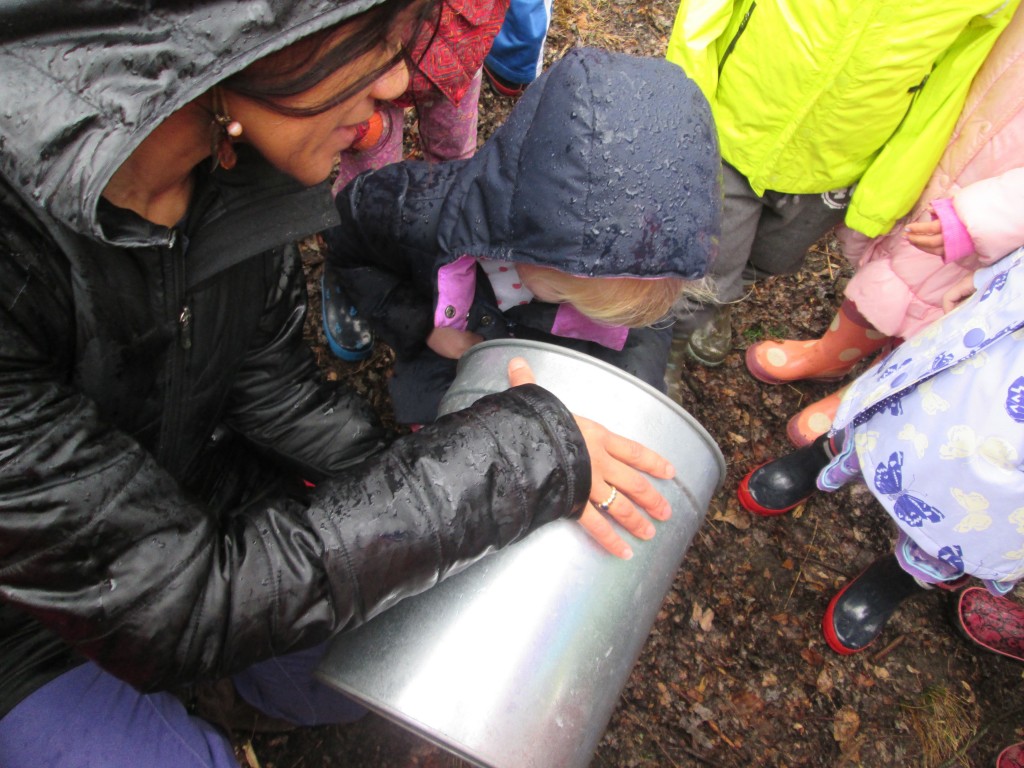 “It tasted sweet. It’s wettish. It tastes like water.”
“It tasted sweet. It’s wettish. It tastes like water.”
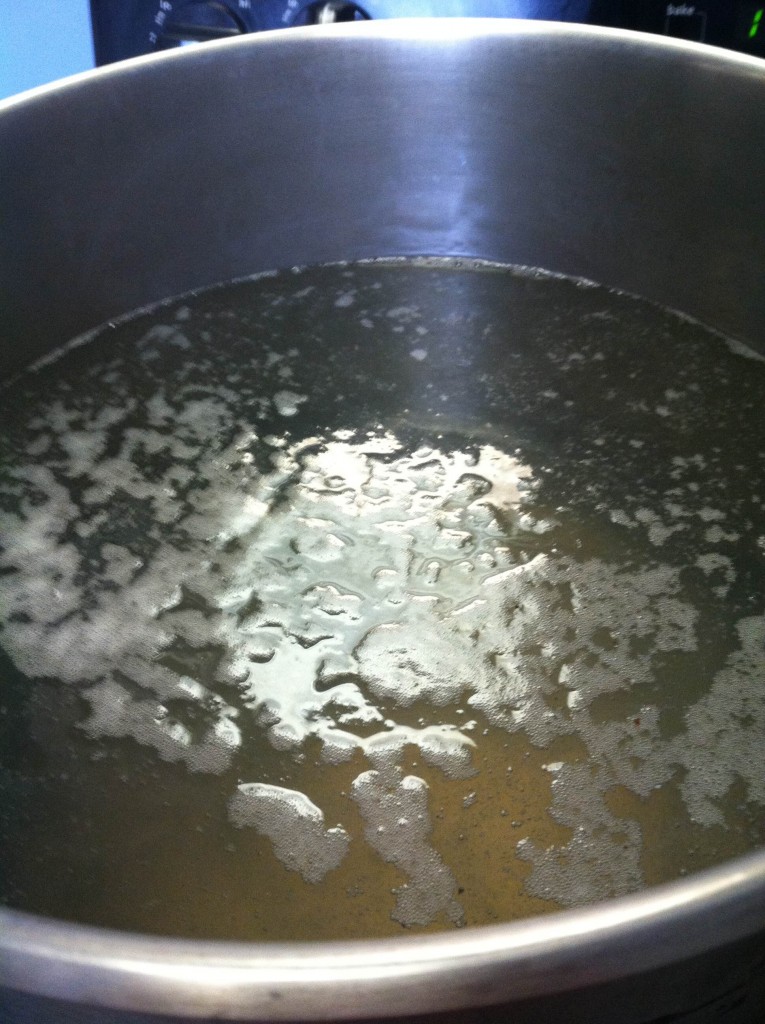 After boiling down the sap for hours and hours and observing the steam rising from the liquid, we saw some changes. “Why is it yellow?” “It’s changed color!” “It smells like chocolate.”
After boiling down the sap for hours and hours and observing the steam rising from the liquid, we saw some changes. “Why is it yellow?” “It’s changed color!” “It smells like chocolate.”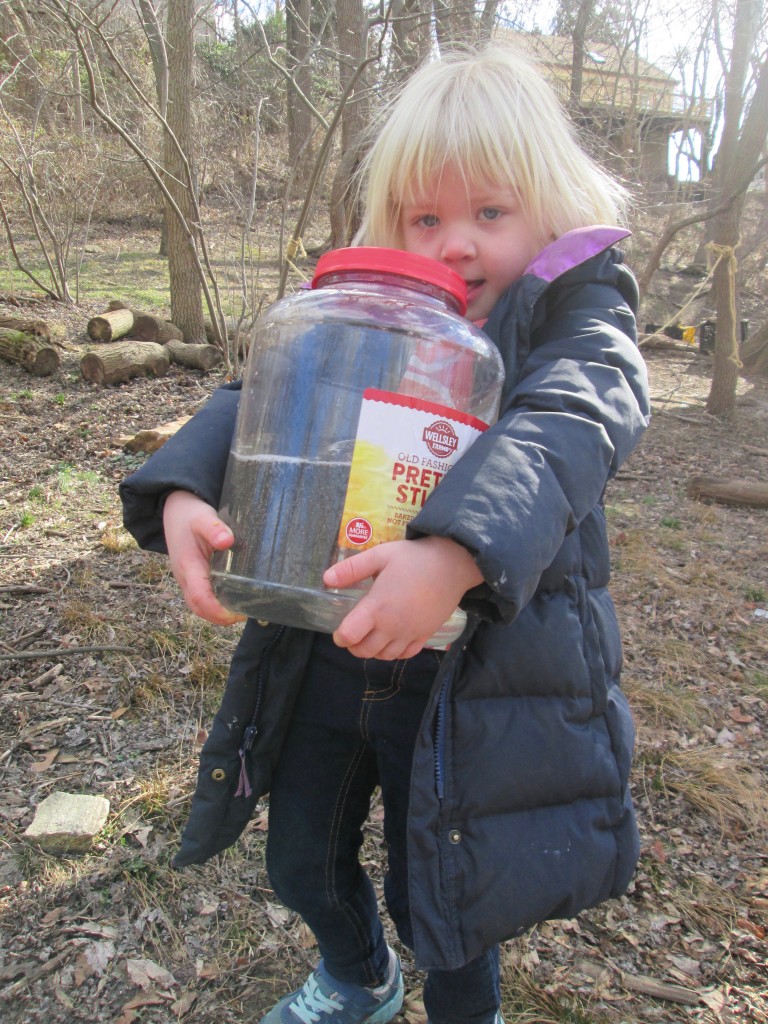 This much sap will make how much syrup?
This much sap will make how much syrup?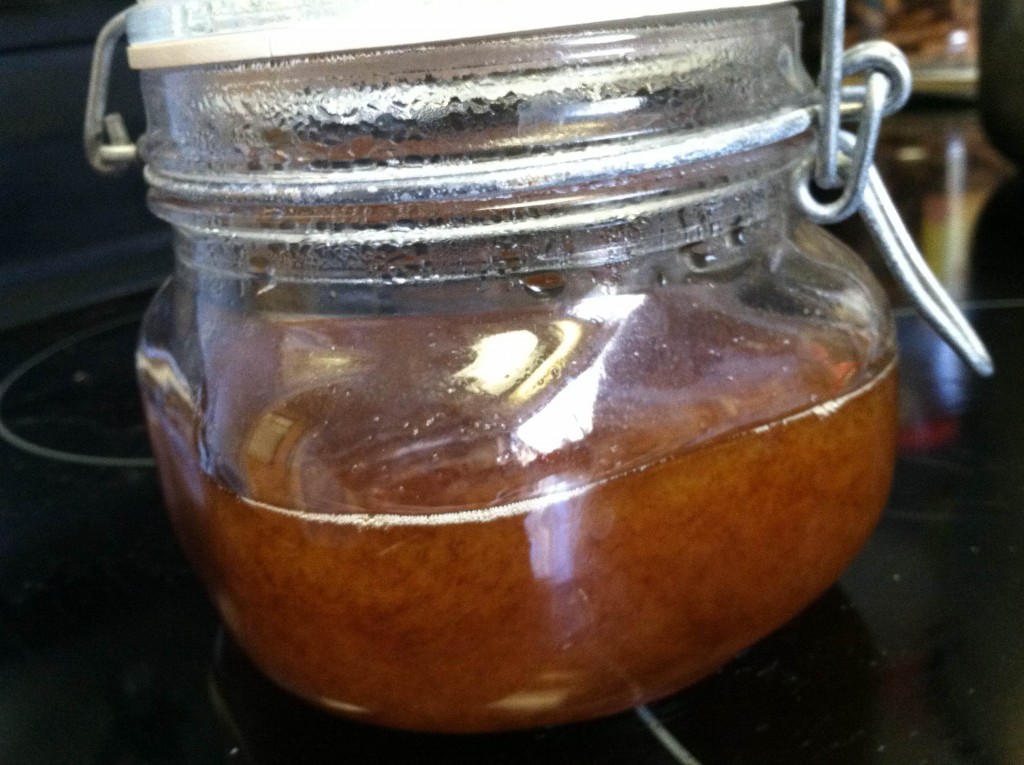 Our first batch of syrup made from several gallons of sap.
Our first batch of syrup made from several gallons of sap.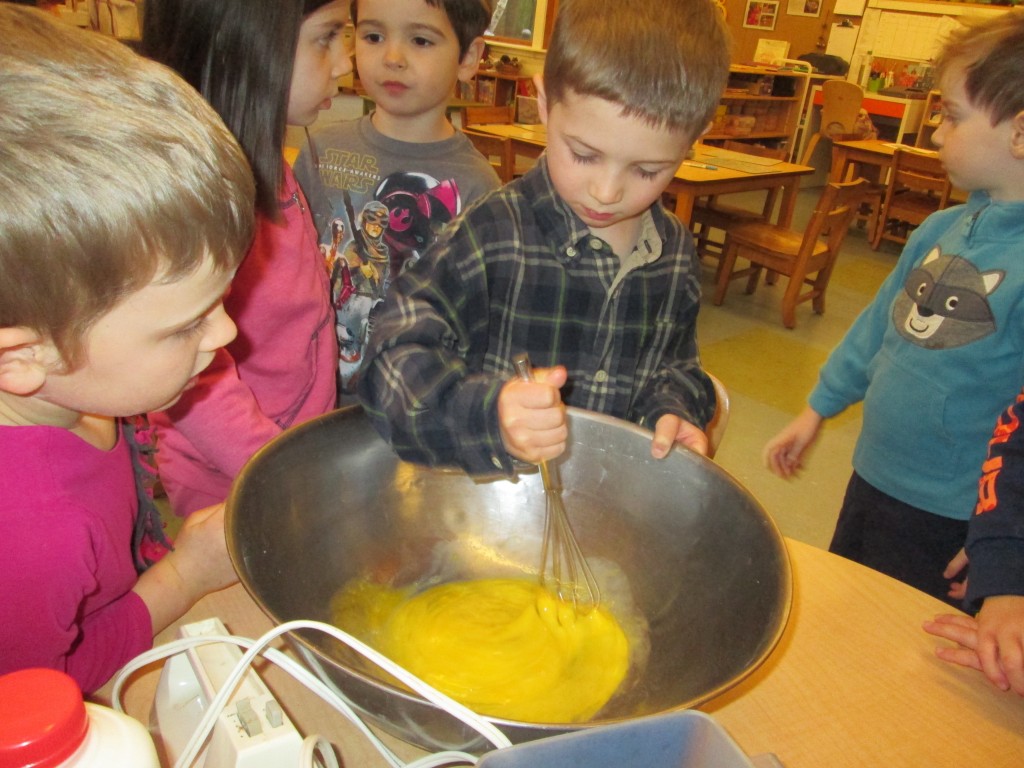 We celebrated our sugaring experience by making pancakes during Choice Time.
We celebrated our sugaring experience by making pancakes during Choice Time.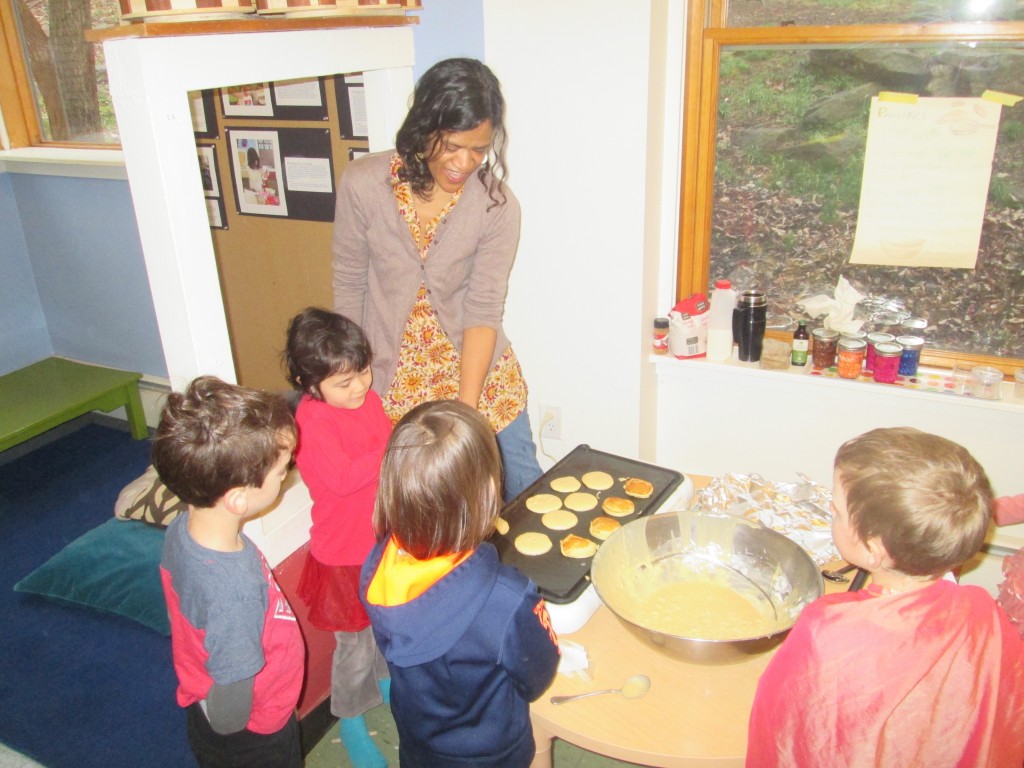 First we counted 19 pancakes. But how many kids are here today? “22.” “Do we have enough?” Nadia calculated that “we need 3 more!” Ariella suggested that we make 22 more. We ended up making 34 pancakes!
First we counted 19 pancakes. But how many kids are here today? “22.” “Do we have enough?” Nadia calculated that “we need 3 more!” Ariella suggested that we make 22 more. We ended up making 34 pancakes!
The kindergarten invited us to bring our pancakes and syrup to their sugaring celebration. Many of us preferred the Miquon maple syrup over the store-bought syrup! Wow!
Inquiry: How can we experiment with collage? 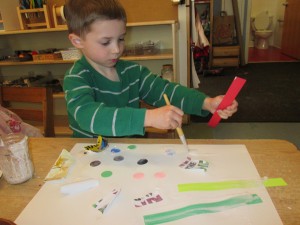
During a read aloud of Leo Lionni’s Matthew’s Dream, we noticed that Leo used bits of ripped papers to create his pictures. Eli made a text-to-text connection that “he used ripped newspaper just like in Uptown!” (which we read earlier in the year by Brian Collier). Looking at these books as well as picturebooks by Ezra Jack Keats, we asked our learners What do you think collage is?
Maya: Take a piece of ripped-up paper, then get some not-ripped-up paper, brush on glue, and press down.
We invited our learners to examine a basket of torn-up paper pieces. Declan noticed a newspaper scrap. “This paper is limp.”
Harriet: I’ve done collage before! When you take pieces of paper and glue and glue it on. The author might have used stamps. He used actually real newspaper. Felix added, “And you also cut the paper and make the shapes.” Yaz observed that some of the paper “kind of feels like fur here, and tissue paper here.” Quinn noticed that some of the paper pieces felt soft.
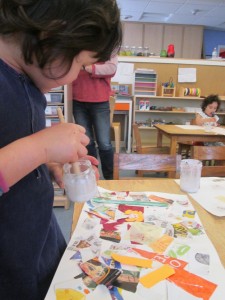 Brushing on Mod Podge to seal layered pieces of paper. “I did so much layering!”
Brushing on Mod Podge to seal layered pieces of paper. “I did so much layering!”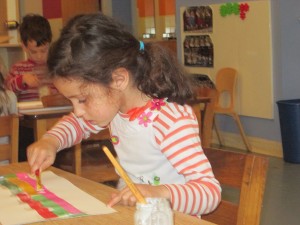 “I’m making two pianos, with 88 keys. This is the roof of the piano.”
“I’m making two pianos, with 88 keys. This is the roof of the piano.”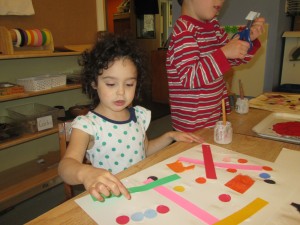 “Do you see my family? I didn’t make my fox.”
“Do you see my family? I didn’t make my fox.”During Writers’ Workshop this month, we met as a group and recalled that we wrote stories about the blizzard a few months ago. Our last workshop was in the middle of winter. Ariella noted, “Now it’s spring.” Maria exclaimed, “Days are getting longer! I can see the sky when I’m eating my dinner!” Miles added, “It’s still light out but it’s late. My mommy told me that when it gets closer to warmer the daylight stays longer.” Eli remarked, “The President said to change the clocks.” After our learners shared these exciting changes that they find meaningful and important in their world, we invited them as authors and illustrators to tell a story in response to the question What is spring to you? Hallie Cirino, in Tell Me More: Listening to Learners Explain (ed. Eleanor Duckworth), notes that giving children a space where they can interact during the writing process fosters their development. “Social skills, phonetic concepts, confidence, and a sense of empowerment all seem to grow during this process” (p. 91). Many of the children shared ideas about wildlife and plants, family experiences, and strategies they use for drawing or finding letter sounds, all of which add to building our community of nursery authors.
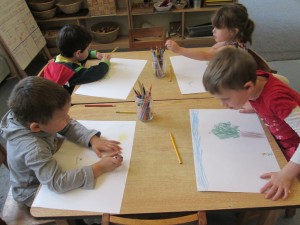 “I’m making a flower. It’s a sunflower. How about we have a publishing party and snacks and gluten-free snacks?” “Spring is so hot so my sun is like gas or something.” “I see flowers in the spring.” “Look at my tree. It’s a maple tree.” “Is it the maple tree from Monkeyland?” “This is rain. That’s the sky and this is a rainbow. It’s really foggy out. There’s a nest. Flowers are still growing on this tree.” “It’s a hornet. Actually a regular bee getting pollen.”
“I’m making a flower. It’s a sunflower. How about we have a publishing party and snacks and gluten-free snacks?” “Spring is so hot so my sun is like gas or something.” “I see flowers in the spring.” “Look at my tree. It’s a maple tree.” “Is it the maple tree from Monkeyland?” “This is rain. That’s the sky and this is a rainbow. It’s really foggy out. There’s a nest. Flowers are still growing on this tree.” “It’s a hornet. Actually a regular bee getting pollen.”Water Exploration took a new direction this month! The softer ground allows for deeper digging and many opportunities for engineering and designing during play. After seeing how sticks can carve out a stream, the children brought up buckets of water from the creek to test out their new waterway. Through experimenting and playing with water, our learners explore concepts of physics and geography. Also, they make connections with interdependence, cycles, and change over time.
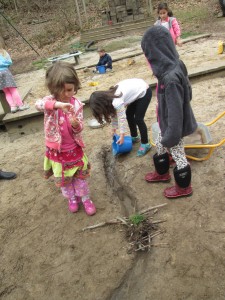 Ariella: The deeper you make the stream the faster it goes. Eli: We need bridges.
Ariella: The deeper you make the stream the faster it goes. Eli: We need bridges.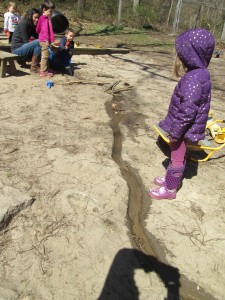 “It’s going downstream.”
“It’s going downstream.”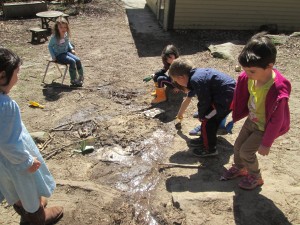 “There’s been lots of floods, so we put this huge dam here to stop the water.” “The dam is not wide enough. We have to make it wider.”
“There’s been lots of floods, so we put this huge dam here to stop the water.” “The dam is not wide enough. We have to make it wider.”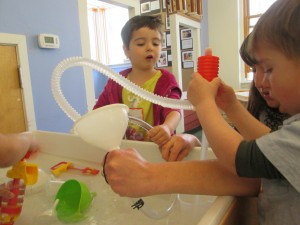 Investigating at the water table with kerosene pumps, funnels, and beakers. “It sucks up water and pours it out.” “How is it getting in there?”
Investigating at the water table with kerosene pumps, funnels, and beakers. “It sucks up water and pours it out.” “How is it getting in there?”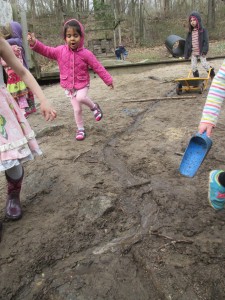 “Go water, go!”
“Go water, go!”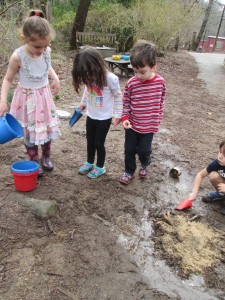 “The water stops and it makes a pond. We need to make more trails for the water to go down.”
“The water stops and it makes a pond. We need to make more trails for the water to go down.” At group meeting, Charlie shared that “to discover” means “to find something out.” The children continue to share what they’re discovering about water. During a read-aloud of All the Water in the World, by George Ella Lyon, we observed that the author makes the words play with the illustrations. Some words are in the shape of a wave. It was fun to repeat the words that show what water does: “Drip, drop, drumming” and to learn that the author uses alliteration with those “drrrr” sounds. The nonfiction text prompted the children to form more questions about water. Eli stated, “So basically the earth has more H2O than land.” Maya wondered, “Has land been getting smaller and smaller and smaller since the dinosaurs? Or is the ocean getting smaller?” These questions led to discussions about the number of people living on the earth. Next, another set of questions from the group emerged: How is water made? How do the rain clouds get the water? How does the earth get water? Declan noted that “plants need water!” Felix inferred that the author painted pipes to show “there’s lots of pipes so there’s lots of water for everyone.” But the book also showed a land that looked dry and hot. Harriet concluded that “It’s a desert.” We look forward to linking evaporation, condensation, and precipitation to our water exploration as part of our emergent curriculum.
At group meeting, Charlie shared that “to discover” means “to find something out.” The children continue to share what they’re discovering about water. During a read-aloud of All the Water in the World, by George Ella Lyon, we observed that the author makes the words play with the illustrations. Some words are in the shape of a wave. It was fun to repeat the words that show what water does: “Drip, drop, drumming” and to learn that the author uses alliteration with those “drrrr” sounds. The nonfiction text prompted the children to form more questions about water. Eli stated, “So basically the earth has more H2O than land.” Maya wondered, “Has land been getting smaller and smaller and smaller since the dinosaurs? Or is the ocean getting smaller?” These questions led to discussions about the number of people living on the earth. Next, another set of questions from the group emerged: How is water made? How do the rain clouds get the water? How does the earth get water? Declan noted that “plants need water!” Felix inferred that the author painted pipes to show “there’s lots of pipes so there’s lots of water for everyone.” But the book also showed a land that looked dry and hot. Harriet concluded that “It’s a desert.” We look forward to linking evaporation, condensation, and precipitation to our water exploration as part of our emergent curriculum.
Inquiry: “I know this is fiction because potatoes don’t have eyes.”
Growing potatoes from potatoes
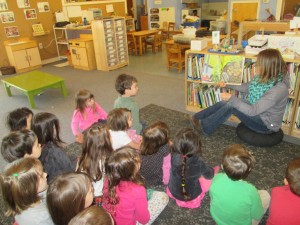 To extend the children’s interest in spring growth and interdependence, Erin read Two Old Potatoes and Me, by John Coy and Carolyn Fisher, about a young girl and her dad who grow new potatoes from old ones. Ariella: The end pages are so beautiful. I know this is fiction because potatoes don’t have eyes. “Collage!” Maya: When I was taking stems off, my mom was saying that those are eyes. I know it’s nonfiction. Sometimes before planting, we have to dig out rocks. Declan: Rocks can be useful to keep it safe. Eli: Remember Science Kate showed how carrots will grow around the rocks and will have bumps? Miles wondered, “Is this nonfiction? Are the people fiction?” They watered, weeded, and waited. “That’s alliteration!”
To extend the children’s interest in spring growth and interdependence, Erin read Two Old Potatoes and Me, by John Coy and Carolyn Fisher, about a young girl and her dad who grow new potatoes from old ones. Ariella: The end pages are so beautiful. I know this is fiction because potatoes don’t have eyes. “Collage!” Maya: When I was taking stems off, my mom was saying that those are eyes. I know it’s nonfiction. Sometimes before planting, we have to dig out rocks. Declan: Rocks can be useful to keep it safe. Eli: Remember Science Kate showed how carrots will grow around the rocks and will have bumps? Miles wondered, “Is this nonfiction? Are the people fiction?” They watered, weeded, and waited. “That’s alliteration!”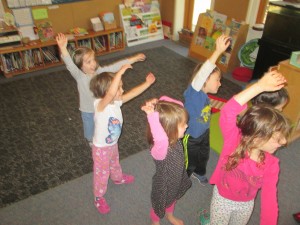 Reenacting how potatoes grow!
Reenacting how potatoes grow!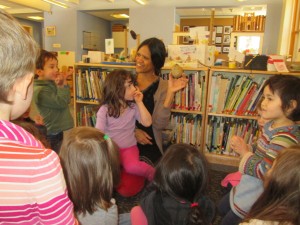 Should we try growing new potatoes from old potatoes?
Should we try growing new potatoes from old potatoes? Adding compost from the worm bin. Harriet: The worms eat old leaves and apples. Their poop doesn’t stink.
Adding compost from the worm bin. Harriet: The worms eat old leaves and apples. Their poop doesn’t stink.Introducing morning sign-in and the job chart.
 Erin introduced us to Morning Sign-in, which we get to do as soon as we arrive to school. Placing our name and photo on the photo that depicts how we’re going home promotes independence, social interaction, and literacy and numeracy skills. We’ve also implemented the Classroom Helper chart that includes various jobs for our learners to select, such as meteorologist, teachers’ helper, and snack helpers. What are jobs? Charlie: Like, fun things. Yaz: You can also put out cots. Charlie: When you put out cots, somebody can help you. The Weather Bear is a new job. Declan: Can Weather Bear be whatever we want? A girl or a boy?
Erin introduced us to Morning Sign-in, which we get to do as soon as we arrive to school. Placing our name and photo on the photo that depicts how we’re going home promotes independence, social interaction, and literacy and numeracy skills. We’ve also implemented the Classroom Helper chart that includes various jobs for our learners to select, such as meteorologist, teachers’ helper, and snack helpers. What are jobs? Charlie: Like, fun things. Yaz: You can also put out cots. Charlie: When you put out cots, somebody can help you. The Weather Bear is a new job. Declan: Can Weather Bear be whatever we want? A girl or a boy?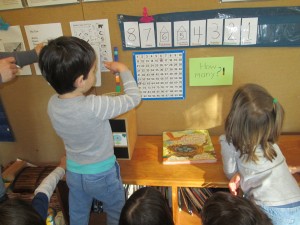 One way of finding the number of children attending school in the morning is to ask everyone present to add a unifix cube to build a stack, count together the total number of cubes, and find that number on the hundred chart.
One way of finding the number of children attending school in the morning is to ask everyone present to add a unifix cube to build a stack, count together the total number of cubes, and find that number on the hundred chart.A story and feather game!
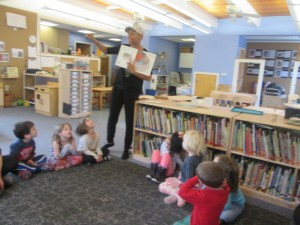 Atiya invited us to co-read the book Nest, by Jorey Hurley, by asking for our help in figuring out the word on each page from her beginning sounds and sign language.
Atiya invited us to co-read the book Nest, by Jorey Hurley, by asking for our help in figuring out the word on each page from her beginning sounds and sign language.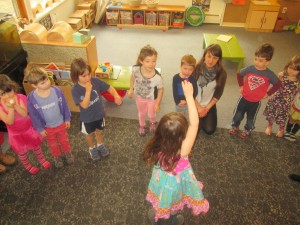 During the Feather Game, one person in the circle drops a feather and asks another person to try to catch it before it falls to the floor. This one is destined to become a favorite!
During the Feather Game, one person in the circle drops a feather and asks another person to try to catch it before it falls to the floor. This one is destined to become a favorite!Inquiry: Mama Panya’s Pancakes
Making pancakes with our friend Cassandra from the recipe included in the book Mama Panya’s Pancakes: A Village Tale From Kenya, by Mary and Rich Chamberlin. They were so savory that many people asked if we could have more the next day! Like our pancake recipe from our maple syrup study, the main ingredient is flour, but the remaining ingredients are water, vegetable oil, salt, and cardamom. Our learners wondered about the story’s setting and shared comparisons and questions about the village life in Kenya. Eli: They must like their houses because their houses are made of straw and wood. And there must not be a lot of tornadoes and hurricanes. And only one place to get water. We also shared what we thought Mama Panya needs from the market. Maria: Knives. Avea: Strawberries. Charlie: Flour for pancakes. Mama Panya’s son Adika enjoys inviting more friends to pancakes that evening. We counted that he invites 7 people! Ariella: She might not have enough money for everyone. Many of the children wondered if this story takes place long ago or if it takes place today. Declan: They tie up their groceries because it’s in the olden days. Charlie: Back then they didn’t have what we have now–water bottles. Miles: Is this a real story or fiction? They were surprised that it depicts village life in contemporary Kenya.
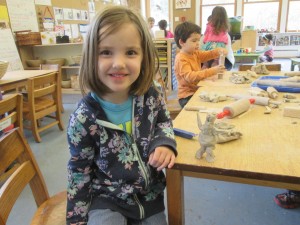 Clay play was another option during Inquiry!
Clay play was another option during Inquiry!Celebrations
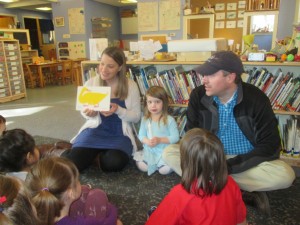 A half-birthday celebration!
A half-birthday celebration!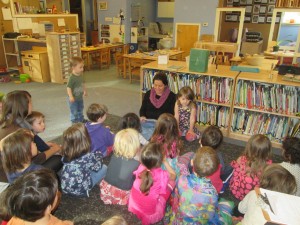 Celebrating Purim with a story and sound effects including bells, cymbals, drums, egg shakers, and rattles.
Celebrating Purim with a story and sound effects including bells, cymbals, drums, egg shakers, and rattles.Playing games in the Lower Field: Run Away, What Time Is It Mr Fox?
